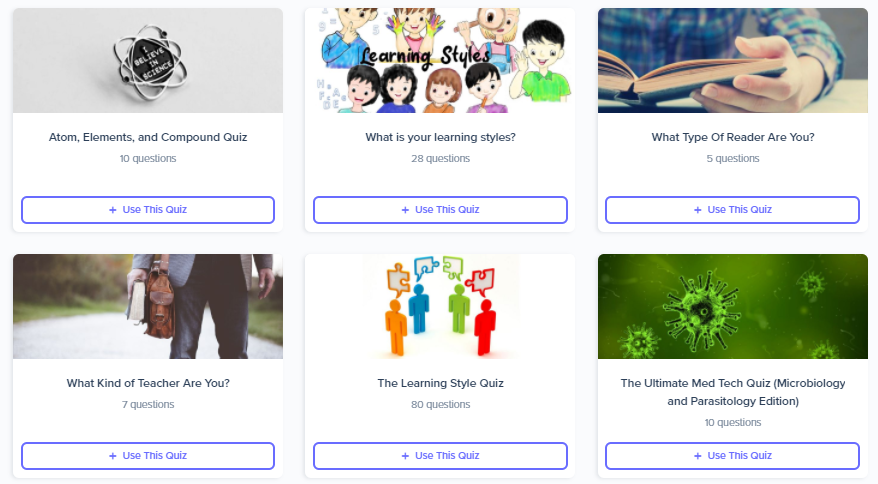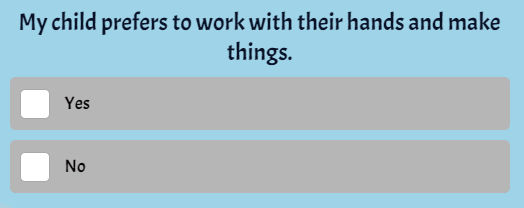The 2020-2021 school year is starting completely differently than any other school year. With many schools and families choosing virtual learning due to COVID-19, the year is sure to be memorable. As a former elementary school teacher, I can only imagine the challenges in connecting with and educating these brand-new virtual learners.
While the majority of the curricular content comes directly from state-developed educational standards (over 40 states use Common Core standards), teachers are frequently given flexibility in how they teach content and ask students to demonstrate mastery of the content. For this reason, many educators choose to begin the year by asking students and/or parents to think about their strengths and challenges, as well as their preferences for receiving and delivering academic content. These have traditionally been completed through paper inventories in the classroom, that’s not an option for many educators this year because of COVID-19 and growth of distance learning.
But that doesn’t mean that educators have to go without the information. Creating a learning style quiz with Interact is an effective way to gather this information in the current situation, plus an online quiz is significantly easier to administer and it identifies the results automatically.
In this blog post, I cover:
- The different learning styles
- Why you should make a learning style quiz
- How to write a learning style quizzes for adults and children
- .Possible questions to include in your quiz to find your students’ learning style preferences.
Let’s get started!
Learning styles—a review
The early roots of learning styles can be traced back to the early 1900s and Dr. Maria Montessori. The Montessori education method contrasted greatly with traditional education as students were given freedom in what they learned and how they learned it. Learning styles didn’t emerge as a part of educational theory until the 1950s, and then grew in popularity during the 1980s and 1990s. Training on identifying student learning styles and how to help students use those learning styles for academic success are commonplace in colleges and universities in the United States and beyond.
What learning styles are
Learning styles refer to the different methods in which people prefer to learn. Auditory or aural learners learn best through listening to information. Visual learners prefer to see information in charts, graphs, and images. Linguistic learners learn through words, and kinesthetic or tactile learners learn through touch or movement. Other learning styles include logical (mathematical), interpersonal (working in groups), or intrapersonal (working alone).
Over time, a multitude of different learning-style theories have developed. The VARK modalities was developed by Neil Fleming in the early 1990s and suggests that students learn through visual, aural, read/write, and kinesthetic means.
Other common learning style theories were developed by Honey and Mumford and David Kolb in the 1980s. Honey and Mumford’s learning styles are activists, reflectors, pragmatists, and theorists, which share some of the characteristics of the VARK modalities, but are more high-level. Pragmatists and activists are both active learners, but pragmatists prefer to figure out how things work in real life. Reflectors have to spend time thinking about what they’re learning, so they’re similar to the intrapersonal learners mentioned earlier. Theorists are all about logic and theories, so mathematical/logical learners fall into this category. The same is true for David Kolb’s styles of assimilating, converging, diverging, and accommodating.
Most people use a mixture of learning styles to achieve academic success. Some students prefer only one style of learning, but successful students are usually competent in multiple learning styles and regularly use numerous types of study habits.
The validity of learning styles and learning style quizzes has fallen out of favor with researchers. Studies have shown that students don’t necessarily perform better when they use their preferred learning style to prepare for assessments. Even so, plenty of educators rely on learning styles in their classrooms. As teachers and professors work to educate a variety of students, they need an understanding of multiple learning styles and preferences.
Why learning styles are important in education
To truly understand why practicing learning styles grew in popularity, it’s necessary to understand what education looked like in the past. Well into the 20th century, there was a one-size-fits-all approach to educating children. Teachers used lectures and rote memorization to teach entire classrooms. With the turn of the century came the Progressive approach to education, which focused on the students as individuals and meeting the needs of those individuals.
Learning style theory fit well within the Progressive movement. Recognizing that students learn differently meant that educators had to move away from using only one method of teaching. They recognized the value of including activities that meet the needs of all of their students.
This doesn’t mean that teachers are expected to only teach each student in their preferred learning style. It means that teachers are encouraged to vary how they teach material and how they assess content. The Progressive movement in education and its focus on meeting the individual needs of students has changed how education works in the United States.
Why you should make a learning style quiz
Learning styles are often assessed and identified through paper learning style inventories. These questionnaires ask students or parents a range of questions about how the student learns best. Some inventories take the approach of statements that students (or parents) state as true or false for the student or ask the students to state whether they “Always,” “Sometimes,” or “Never” use the suggested learning strategies.
Creating an online learning styles quiz allows a similar experience for your students and parents, but it is completely virtual. Using a digital version also works for in-person learning. Many districts are choosing to utilize digital options inside the classroom because it reduces contact between students.
Another benefit of using an online quiz to assess students’ learning styles is that it encourages students to think about how they learn. An important part of education is helping students understand how they think, how they learn, and what they need to be successful. This focus on metacognition empowers students to become independent learners who are able to succeed, no matter what content they might study in the future.
Customization is another benefit of a learning style quiz. If a student scores high in the kinesthetic learning style, teachers can customize study strategies that work best for kinesthetic learners. For auditory learners, quiz results could recommend that students record themselves reading notes aloud after class so they can relisten, or to choose a study spot away from other people to avoid distraction. For visual learners, quiz results could suggest types of graphics that work best for the relevant content., including tools like downloadable blank graphic organizers. Creating quality results pages that fit with the various learning styles is a way that you can meet the individual needs of your students inside and outside of the classroom.
One of the concerns with focusing on learning styles is that a teacher who focuses solely on a student’s preferred learning style does not provide them the opportunity to learn other, possibly more successful, learning strategies. A better approach allows students to learn multiple strategies, so they can use the most effective strategy for each situation they encounter. It’s an excellent idea to share all of the results pages with your students or quiz-takers, because someone who gets the visual learning style as their result might benefit from one of the strategies provided to your interpersonal, or social, learners.
Most people use a variety of strategies that fit with a wide range of learning styles, and it’s always a good idea to teach them a few more. The more “tools” (strategies) someone can implement, the more successful they can be.
Creating a learning style quiz
Now that you’ve reviewed what learning styles are, it’s time to make the quiz!
When you’re creating your quiz, consider who your quiz is for. Your audience should influence the questions you ask, the wording you use, and the results you provide. A quiz for high school students will look substantially different than a quiz for parents of early elementary students. Creating an online quiz for college students looks nothing like a quiz for fifth graders.
Because there’s such a wide range between these different audiences, I’m going to walk through the process of creating a learning style quiz for adults and another for children. That way you’ll be prepared for whatever type of quiz you choose to create.
How to write a learning style quiz for adults
Once you identify that your quiz audience is adults, you’ll still need to narrow this down further. Are you writing for adult students or for the parents of your younger students? (By adult students, I mean 10th grade or older students. While 10th grade students aren’t legally adults, their vocabulary and reading level are more similar to those of an adult than a young child.) Once you’ve established an age group, you can start writing your quiz.
From your Interact dashboard, choose a template and then a template category. If you look in the Education templates, you’ll find templates for learning styles quizzes. Make it easy on yourself and start with one of those!

Choosing a quiz template that matches the purpose of your quiz has several benefits. You’ll likely find included stock images that will fit with your quiz. You might also find questions and results to include in your quiz that you hadn’t considered. You can often build your quiz within a few hours.
If you look in the image above, there are two learning style quiz templates that you can use. They’re the two quizzes in the middle column. Both of these quizzes listed are personality quizzes. Since personality quizzes sort quiz-takers into categories based on their answers, that’s the best choice for a learning style quiz.
(Here are explanations of the other types of quizzes you can create with Interact, if you’re interested.😉)
As you look at the Education templates, you can easily tell the difference between the audience for the two learning style quizzes. The top one works best for young children (or their parents) and the bottom one is best for adult students. You’ll also notice that the top quiz has 28 questions and the bottom one has 80. If it’s been a while since you’ve been around small children (or since you were a small child), 80 questions would overwhelm anyone under age 13!
Whichever quiz you choose, you can customize it however you’d like. You can delete questions that aren’t applicable to your quiz or change it to better match your audience and learning styles.
In the learning style quiz for adults, the results are from the Honey and Mumford learning styles. The results of activist, pragmatist, reflector, and theorist are more abstract than visual, auditory, and kinesthetic. These would also be too challenging for younger students to understand.
As you’re creating your quiz, you can always change the results and alter the questions to fit with the learning styles you include.

The adult learning style quiz is set up with true-false questions. Here are some examples true-false statements that work for either the Honey & Mumford learning styles or the visual/kinesthetic learning styles:
- I tend to solve problems using a step-by-step approach.
- In discussions, I enjoy watching the maneuvering of other participants.
- I’m eager to try things out to see if they work.
You might also consider including work-related statements such as “I work best in groups” or “All my best work happens when I can work independently,” which give adults the opportunity to think about their preferences.
If you’re creating a quiz for small children or the parents of younger students, the What is Your Learning Style? Quiz is a better choice. Children won’t feel overwhelmed with a smaller number of questions. The questions and answers are also more applicable to a school setting.
You can also choose to include questions about how their child prefers to study, what types of activities they prefer, and how they are best able to remember things. These are questions that parents and students readily know the answers to and fit well with the quiz results. You can also choose to set up multiple choice questions or keep them as statements like the example below.

You can see below recommended study strategies that benefit a student who’s test results show a logical learner. Including three to five strategies can help parents understand their child’s strengths and how best to help them prepare for tests. The strategies aren’t included in the templates, but you can include whatever strategies you want to focus on. The adorable cartoon images used in this quiz are perfect for a quiz that’s meant to appeal to young children.

How to write a learning style quiz for students
If you’re creating a quiz for middle school students, you can choose from the same two learning style quiz templates. While the shorter quiz might be a little more appropriate in length for these students, the images wouldn’t appeal to students of this age. If you prefer to use the quiz that’s more appropriate for adults, you’ll need to make changes to the questions and results.
You might choose to change the questions for true-false to multiple-choice questions. This lets you reduce the number of questions in your quiz. Some of these multiple-choice questions could be situational. For example:
Q. You have a new project for class. How do you prefer to work on it?
- working with a small group of friends
- completing it independently
- doing the project with a partner
Another question might relate to how they study. For example:
Q. How do you best prepare for a test in class? (Select all that apply.)
- reread the content
- create rhymes or songs for the key topics
- draw pictures and graphic organizers for concepts
- review with a study group.
In the quiz results, explain to your students their top learning style and how they might see it in their lives. You can also include some study strategies that they would benefit from.

You should also provide information about other learning styles, so the students can explore other strategies that might help them. Remind students of some of the more helpful strategies as they get closer to assessments in your content area.
If you want access to your quiz-takers’ results, use the lead generation feature on your Interact dashboard. You’ll create an opt-in form for your quiz, your quiz-takers will input their name and email address before they see their results, and then you can download the CSV with your quiz-takers’ results.
You can use this information to encourage activities that align with your students’ preferences and challenge them to try new strategies that might help them learn. It’s an excellent way that you can support your students whether they’re participating in virtual or in-person learning this year.
In this post, I’ve covered:
- The different learning styles and their backgrounds
- The benefits of learning style quizzes
- How to create learning style quizzes
Whether this is your first time encouraging students to think about their learning styles or you’ve been at this for a while, you now know everything you need to create a learning style quiz.
All that’s left is to go make your quiz. I hope you and your students have a safe and healthy school year!
